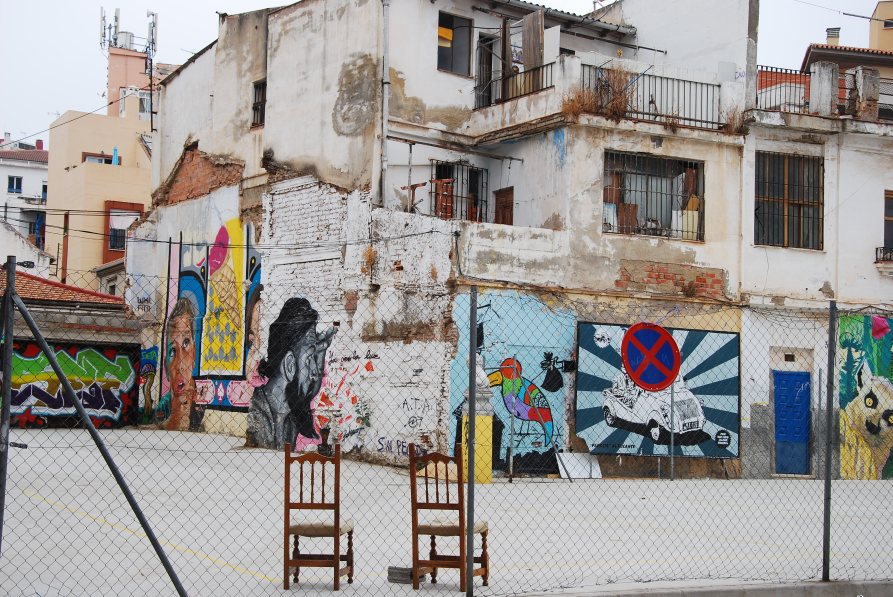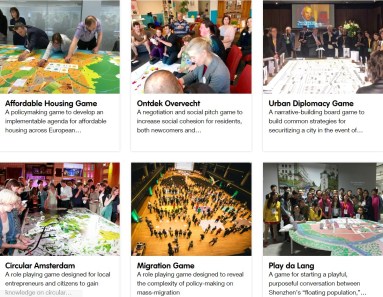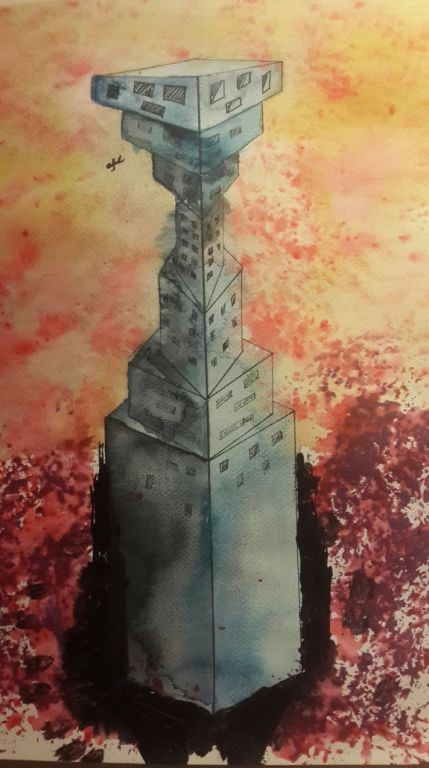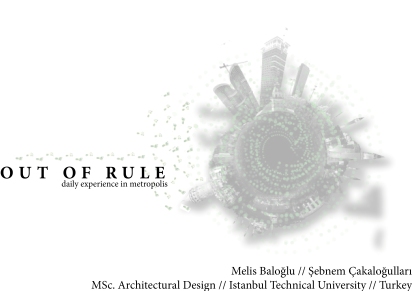
ABSTRACT
The game in its broadest sense is an amusing way to spend time in every field. But the thing that breaks the amusement is the certain, general rules of the game against rapidly changing world in the scale of urban. That is why the pressure on the individuals can be felt. They are independent from each others in a metropolis, due to reach the minimum values of life to meet their basic needs from the time that they prefer to live in fixed rules of ordinary games which are vicious.
Today’s the higher population number brings less interaction between individual and individual, individual and nature, individual and metropolis. The habits of people are organized by their every day experience, supported by ordinary mono-functional devices in urban scale and their habits turn into their rule in a roundabout ways. The term, -functional, represents the ability of materials surprising people who use them. Then, the ordinary life is over floated by rigged game.
The frame of ordinary life is broken. Breaking the routines associates with sharpening and the strongest changing on the each personal rule is achieved by the radical changing on the urban context. The question is where this radical changing comes to place in metropolis like Istanbul. Through the analysis and observations, discussed in article, there is no special place but there is a dominant character helping to create a new game which is related to urban furniture.
The recommendations, in the article, are categorized as sub headings developed for each of the scenarios developed according to vertical and horizontal urban furniture and their material quality which is specified as solid, soft and smooth but totally opposite usage what we are used to. Finally, daily used urban furniture creates it selves illimitably according to individuals’ perception and The Game never stops!
Key words: routine, interactions, urban furniture, metropolis, experience
INTRODUCTION
The word, called metropolis, simply involves the variety of culture and history, crowdedness. Correspondingly the reflection to the life of habitants must be joy full. However unlike the understandings of the experienced existence in the city, the life in metropolis consists of facing the very simple, basic needs in our global world. Here people move fast hail taxis, wait for traffic light, meet people and go to work. Invisible forces and unwritten laws determine why people move and pause in streets. Through the critics about our century, it is so obvious that the media and the other communication technology just serve the direct and the visual percepts. Instead of exploring other vicarious vital feeling it is just caught the simple side of sense. Then every time it is repeated and nothing, new experiments, occurs. The problem that is handled by the project which magnifies the everyday life is about experiencing or skipping life in the metropolis. With respect to these questions, the aim is to seek the way for saving the habitants of the metropolis from the one dimensional, mono functional space through changing their experiences during the travelling in the streets.
In the beings life, city has an important role not only sustained their life but also increasing social interaction that is called game. However people who live in minimum perceptual demands are ignored the importance of habitat by ceasing the interrupting role of the speed of everyday life and environmental forms that make us alienate from public experiences. According to understanding of city for Lynch (1960), the roads and streets, determining the shape of the city, are usually identified as an open space for the public[1]. Rather than determining the structure of the city, today’s they give shape to beings movements. Despite of what we are dictated about public and private space, in the practice our acts are turned to be our routines by the limited urban interaction in the openings of the city, due to the quality of them which are places to be passed through.We highlight social control, mutual trust, institutional resources, disorder, and routine activity patterns.
In metropolis, lacking of meeting with others destroys the chance of joyful experiences because meeting with different people enlarges the experience. Through time, the memories of place become routine. Each time this routine repeated then it becomes experience. How this constant experience in metropolis can be broken is the essential question of the article. Build environment should help people to meet and create surprises. That means, urban furniture should be re-active and break the memory of routine but from the other side it should store the memory. (Figure 1.Activity classification)[2]
The handled problem is lacking of interaction which is based on the standardization and specific order of the urban context, furniture. As the explanation of Eroğlu and Kesim (2001) the urban furniture is the objects, designed with being in line with the rule and minimum value, reduce self being characteristics[3]. The important point is telicity of the design. It means telicity of the percept too. According to Rapoport (1982) space gives direction people behavior with the object in it[4]. With the telic aspect order makes being feel as if under command and tame them. This totalitarian control erases the people percept.
Breaking the heavy frame of telicity between the habitant’s routine and the potential of the urban life is related to changing the perception of the city. This idea brings its question in the meanwhile. How this concrete urban rule and the system are let the habitants support their sense of experiences? Mostly we are acting unconsciously due to live in routine. This paper is seeking the way ,out of rule, by offering a new urban furniture, atelic order, to the city against classic ,cut and dried urban form and material usage due to what we see is what we percept any time.
ROUTINE, INTERACTION, METROPOLIS, PUBLIC SPACE
According to the statement of Moss (1989), ‘man is shaping and being shaped by the world[5]’. Simply defines the mutual effect between the man and built environment. It can be identified as the livings in the metropolis subjects to challenge and supervision. Simmel (1902) thought about how the beings psychologically react against these limitations[6]. Together with this two reasonable sense, our interaction with the environment naturally is set by what habitants take and what they give to the city. The first point is the thing, taken from the city that the main reason for making them monotone in the frame of the urban beings social interaction. The things that taken from the city are meant to be free, open, public space that involve maximum particular beings in theory.
The meaning of the metropolis comes from Greek word and means the “mother city” of a colony (in the ancient sense), that was later generalized to a city regarded as a center of a specified activity, or any large, important city in a nation. According to streets and roads that vivify the city; provide to habitants free swing. On the other hand the streets determine the structure and the shape of the city. The idea behind Lynch (1960) notion is much developed street wire brings improved urban structure so these traces take away context, solids and voids. The unity of the structure of the metropolis and social understanding of metropolis from Greek term bring the minds today’s metropolis[7].
Then when looking Jacob (1993) he proclaims that “Sociability is a large part of why cities exist and streets are a major… “By focusing on the social roles[8]. In terms of sociality approaches through the metropolis life, Oldenburg (2001) classified the spaces and third space where everyone has possibilities to get in touch with others is defined outside of the working place and homes[9].’ Although 3rd place refers to social surroundings, it is separated from the two usual social environments; home and the workplace and street can be also defined theoretically. Streets facilitate social contact, social awareness and social cohesion (Mehta, 2007)[10]. As we put differently, streets provide opportunities for short-term, low-intensity contacts that constitute easy interactions with other people in a relaxed and relatively undemanding way (Gehl, 1987). To sum up, 3rd place focuses on the social aspect. In this point human activities are key factors that contribute to the character of place. Then Schultz (1980) genius loci explains better the human percept in the urban context[11]. The term a genius locus refers, ‘if the settlements are organically related to their environment, it implies that they serve as foci where the environment is condensed and ‘explained….Protecting and conserving the genius loci means interpreting it in ever new ways. ‘The relation between the parameter of the environments and the objectivity brings the interpretation in every time the originality for each experience. In addition to changing’s, the others are concrete. Through the space classification of Schultz (1980) existential space is based on the tangible perception and together with the cultural background of the perceiver. The fractionation of time and space turn the tangibility into intangibility. The concrete experiencing of the existential space limits the interpretation all the way along the line of transformation of the percept into non-physical because of particular functional and material limitation of the public places of city (Madanipour 2004)[12]. Although the functions of the public spaces are not served as one reason the main idea behind them meeting necessary activity. So every specialized function creates point to be connected for the habitants. It causes fragmentation in the urban structure. Between these destinations the streets are just stayed as a stairs of the ordinary apartment block. Through this line in the urban streets and other, out of necessary spaces like the categorization of Oldenburg, is served the habitats as service core in a regular structure. Streets and squares give way to vast open spaces and flexible location of high-rise buildings, subordinating the void to the mass, undermining the space of sociability (Madanipour 2004)[13]. These nonfunctional voids are the only platform for all habitants who have chance to be in interplay others. Through the urban rule and condition of the transitional spaces, in public, are impermanent and transient although their objectivities are certain, concrete and static.
The action in these axes is routine as walking. This monotonous experiment on this line of the urban blunts our interpretation power and generalization is occurred. These neutralize its surprises by unearthing the old experiences in memory. Instead of being renewable, it turns into foregone conclusion and the variation of the perception is no more mentioned. The built environment, in a relation with the body, orientates the beings towards the element of the test that the result is already known by experienced. That is why the beings are used to move slowly but surely under limitation without conscious. They lose their ability of interpretation, communication, understanding, observation, questioning, specified the specialties of beings. Built environment has a
great impact on pressing or revealing the subjectivity.The unity and straight lines, are alien to human being (Hundertwasser, 1990)[14], are driving apart rather than taking attention of the beings. As a conclusion of this chapter through the shared thought of theories, the urban design assumes that it is a mechanistic discipline. As a result, rigid design occurs. The context like mechanical system does not fit. The important thing is, as Doxiadis (1966) also mentioned, in which Between Utopia and Dystopia in terms of success of the utopia, about lacking of internal cohesion[15]. The metropolis cannot be evaluated like Descartian way for understanding each part to understanding hole. This idea brings the mechanic approaches to the urban context. The connections between the elements are not well elaborated. As a result each layer is stayed separated. (Figure 2.Segregation-Figure 3.Unificaiton)[16].
OBSERVATION
Methodology
The segregation in the street of metropolis is observed under the routine placement of urban furniture and perception. In order to understand the relation between the pedestrian flow and the use of streets, the visual observation and photography are used as a technique of the study. Because instant shots identify the non-exhaustively first impression.Mostly we are acting unconsciously due to live in routine. From its beginnings, photography has been used as a tool for the exploration of society, and photographers have taken that as one of their tasks (Becker, 1974)[17]. When people try to present their instinctual expression in one speech order, it is limited by the resistance act of telling. This is done by the photography analysis, urban plan sample, and movement analysis to catch the moments in the speed of life.
Through the analysis of the activity and movement in metropolis, a new universal model of urban design technique parameter is systemized for newly urban furniture that will be designed. Diagrams include different age groups of people at one coordinate and hours of day represent in another axis. The lines hatched between these two coordinates mean the usage of street. The aim is to find the densest variety hours that people move in the street to create urban furniture that can act during these periods of time and increase the level of interaction between people in metropolis.
Result
By referring the idea of routine, looked like chaos, the observations took place in random squares and streets in the metropolis as first. Common results of detailed observations listed below. In the results that listed, the alphabet A, B, C, D and E symbolize age group below. The habitant based analysis, outside of the private space, brings this age classification and the period that stay outside during one day in which the urban interaction potentially there.
A: ELDER PEOPLE
B: WORKING PEOPLE
C: AFTERNOON PEOPLE
D: CHILDREN
E: TOURISTS
Human traffic is dense when people start to work and quit the work. B people do not have time to use urban furniture during working times but they easily follow signs and traffic lambs. They walk through them, they pass them. Light means security in metropolis not only lightened the darkness but also traffic lamps. People walk towards where the light is because they are afraid of dark. And using traffic lamp for crossing the streets or stop. Crossroads serve as public squares. Because everyday these points are the only stops before crossing the road. They physically act as public squares because of the high dense of people, as well as they are the most diverse area where people and traffic meet. People attract people. As Whyte (2004) mentioned, what attracts people most, it would appear, is other people[18]. Also Gehl (2011) dictates ‘…outdoor activities are greatly influenced by physical planning…’[19] This physical planning also brings the materiality together. All along with the sidewalks that creates pedestrians pathways, the material is the same and this makes out the same sense. The eye always catches the routine. C people, who do not work, move slowly randomly. B people population raises the rhythm of the public space in the morning and in the evening. Rhythm repeats itself everyday and becomes routine.
Street is a place for communication for A people. They sit and observe around and become social in streets. A people sit where they can rest. They try to find a tree to cover their head or lean against it. Some walls also serve as benches. Street vendors sometimes slow people’s movement down and make place alive with their voice and just being there.
The outcomes from this chapter can be concluded that even places chosen randomly, the results are in common in metropolis because the physical conditions of urban life and potential use of public space are nearly neglected in global world. With the usage of public furniture, it is impossible to any character of public space. The point that creates the uniqueness of the space is interaction with the people via help of the urban furniture as a tool.
DISCUSSIONS&SOLUTION
In the process of way-finding, the strategic link is the environmental image, the generalized mental picture of the exterior physical world that is held by an individual. This image is the product both of immediate sensation and of the memory of past experience, and it is used to interpret information and to guide action[20]. (Lynch, 1960)
Every pedestrian draw their personal environmental image that is why it is important to focus on general perception. Urban furniture can store past experience of its time and place. That’s why observations in metropolis are considered as rules to form them. Oppose to top-down approach, the new approach should build where the human in the center and other parameters circle around with interaction of people. Others parameters that break routine perception are environmental varieties: light, seasonal factors like rain, heat and moisture etc… Results through analysis focus strongly on the interaction between people in public life in the public spaces. Design of urban furniture should begin with an analysis of the activities. Pedestrian living in metropolis like İstanbul show that everyday routine of people does not allow interaction. Capacity in public space explains the communication between people in real meaning. Gehl (2011) describes types of activities as necessary activities, optional activities and social activities. Social activities, as Gehl describes…’are all activities that depend on the presence of others in public spaces[21].’ They cannot be evaluated like Descartian way for understanding each part to understanding hole.
Analysis also proves that, E stands whole day in street. For D, it is only possible when they are on the way of school early in the morning, lunch time in the noon and the way of turning back their home in the afternoon. Correspondingly, like D, A and C act in the streets.(Figure 4. The usage of metropolis) From this model, it is understood that noon and afternoon hours have the potential for meeting and conversation. After this analysis, urban furniture is designed by considering to seasonal transformation of earth. The parameters of design are seen as light, moisture, heat and rain. They are necessary design parameters not only for communication between people and people but also communication and interaction for people and urban furniture. With this specific time period on the table for evening light issue creates security problem. That’s why just one side, lamp stands in a linear order ,are used. The rest of streets are abounded. As one solution, light is contradictorily used as a pavement element. It is large scale solution seen from everywhere and invites people to the street. (Figure 5. Light system in the pavement).
Potential meetings occure at specific time that B people, go to work and turn home. Altough these kinds of necessary activities at outdoors make people isolated from any other things in terms of talking and meeting. Being able to see other people in action takes attraction.
For noon time especially variety of pedestrians use the public in high rate according to table that prepared from the observation in the city. The monotone floor pattern and concrete material accelerate people’s movement. Ordinary rigid road material should gain elasticity to make people surprised. They should change their attitude according to crowd of people. To expand the duration of activities in outside, the regional and climatic factors should be considered. Therefore materials should adapt to the environmental changes. (Figure 6. Transformability).
As a conclusion in today’s global world is seen by the analysis of random places in metropolis. In despite of observation from different places, the roles and discussions are the same and every man becomes a prototype, made by physical world in metropolis. So they do not have different words to communicate. If urban design gives a tool to shape the prototype, prototype changes. In relation to this metropolis starts to change.
As a manifestation, and conclusion of this article;
Urban furniture should be used to create hybrid environment.
Urban furniture should store heat during summer and transform it in winter.
Urban furniture should store the solar light during the day time and illuminate the environments during night.
Urban furniture should absorb moisture, rain and snow and serve dry place to people.
Urban furniture should react both seasonal changes and people.
BIBLIOGRAPHY
[1]Lynch, K. (1960). The image of the city (Vol. 1). MIT press.
[2]Lamit, H., Ghahramanpouri, A., & Nia, S. S. (2012). A Behavioral Observation of Street Liveliness in Meldrum Walk, Johor Bahru of Malaysia. International Transaction Journal of Engineering, Management, & Applied Sciences & Technologies, 4.
[3]Kesim, G.A. ve Eroğlu, E., “The problems of Turkish urban furniture in terms landscape architecture”, 1.international urban furniture symphosium, İstanbul Metropolitan Municipality, 137-144, 2001
[4]Rapoport, A. (1982). The meaning of the built environment: A nonverbal communication approach. University of Arizona Press.
[5]Steele, J., & Moss, E. O. (1998). PS: A Building by Eric Owen Moss (Vol. 1). Images.
[6]Simmel, G. (1902). The number of members as determining the sociological form of the group. I. The American Journal of Sociology, 8(1), 1-46.
[7]Lynch, K. (1960). The image of the city (Vol. 1). MIT press.
[8] Jacobs, A. B. (1993). Great Streets. Cambridge: The MIT Press.
[9]Oldenburg, R. (2001). Celebrating the Third Place: Inspiring Stories About the Great Good Places at the Heart of Our Communities. Da Capo Press.
[10]Mehta, V. (2007). Lively streets determining environmental characteristics to support social behavior. Journal of Planning Education and Research, 27(2), 165-187.
[11]Schulz, N. (1980). Genius loci. Towards a Phenomenology of Architecture.
[12]Madanipour, A. (2004). Public and private spaces of the city. Routledge.
[13]Madanipour, A. (2004). Public and private spaces of the city. Routledge.
[14]Kvale, S. (1990). Postmodern psychology: A contradictio in adjecto?. The humanistic psychologist, 18(1), 35-54.
[15]Doxiades, Konstantinos Apostolou, (1966),Between dystopia and utopia, Trinity College Press
[16] E. O. Moss (1991-1996),Building and Projects,Piliph\preface Johnson;introduction Wolf Prix
[17]Becker, H. S. (1974). Photography and sociology. Studies in the anthropology of visual communication, 1(1), 3-26.
[18] Whyte, William Hollingsworth, The Social Life of Small Urban Spaces, third edition, New York 2004, p.19,96
[19]Gehl, J. (2011). Life between buildings: using public space. Island Press
[20]Lynch, K. (1960). The image of the city (p.1). MIT press
[21]Gehl, J. (2011). Life between buildings: using public space (p.11). Island Press
FIGURES
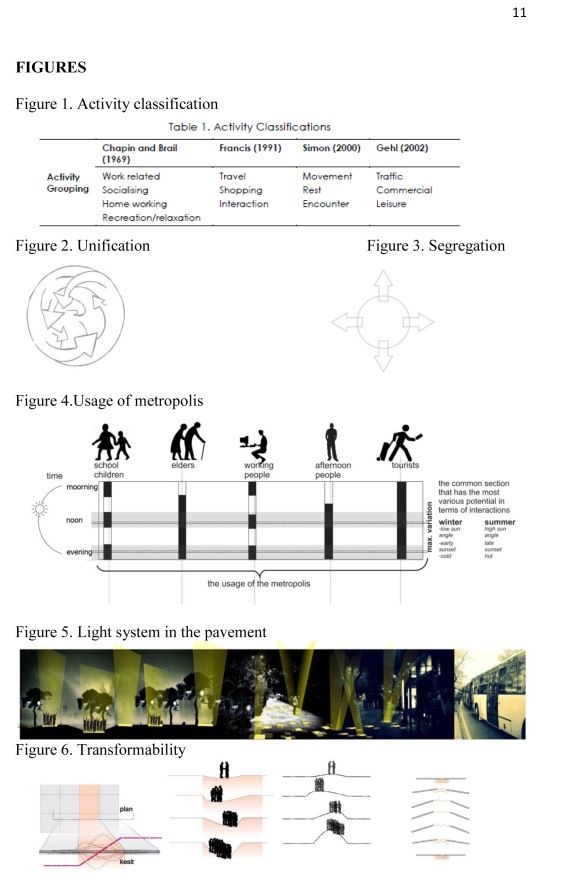
Image by Baloğlu, M. & Çakaloğulları, Ş.
